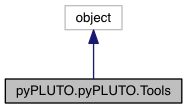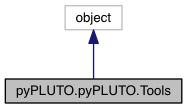|
PLUTO
|
|
PLUTO
|


Public Member Functions | |
| def | deriv |
| def | Grad |
| def | Div |
| def | RTh2Cyl (self, R, Th, X1, X2) |
| def | myInterpol (self, RR, N) |
| def | getUniformGrid (self, r, th, rho, Nr, Nth) |
| def | congrid |
This Class has all the functions doing basic mathematical operations to the vector or scalar fields. It is called after pyPLUTO.pload object is defined.
Definition at line 742 of file pyPLUTO.py.
| def pyPLUTO.pyPLUTO.Tools.congrid | ( | self, | |
| a, | |||
| newdims, | |||
method = 'linear', |
|||
centre = False, |
|||
minusone = False |
|||
| ) |
Arbitrary resampling of source array to new dimension sizes.
Currently only supports maintaining the same number of dimensions.
To use 1-D arrays, first promote them to shape (x,1).
Uses the same parameters and creates the same co-ordinate lookup points
as IDL''s congrid routine, which apparently originally came from a VAX/VMS
routine of the same name.
**Inputs:**
a -- The 2D array that needs resampling into new dimensions.\n
newdims -- A tuple which represents the shape of the resampled data\n
method -- This keyword decides the method used for interpolation.\n
neighbour - closest value from original data\n
nearest and linear - uses n x 1-D interpolations using scipy.interpolate.interp1d
(see Numerical Recipes for validity of use of n 1-D interpolations)\n
spline - uses ndimage.map_coordinates\n
centre -- This keyword decides the positions of interpolation points.\n
True - interpolation points are at the centres of the bins\n
False - points are at the front edge of the bin\n
minusone -- This prevents extrapolation one element beyond bounds of input array\n
For example- inarray.shape = (i,j) & new dimensions = (x,y)\n
False - inarray is resampled by factors of (i/x) * (j/y)\n
True - inarray is resampled by(i-1)/(x-1) * (j-1)/(y-1)\n
**Outputs:**
A 2D array with resampled data having a shape corresponding to newdims.
Definition at line 1129 of file pyPLUTO.py.
| def pyPLUTO.pyPLUTO.Tools.deriv | ( | self, | |
| Y, | |||
X = None |
|||
| ) |
Calculates the derivative of Y with respect to X. **Inputs:** Y : 1-D array to be differentiated.\n X : 1-D array with len(X) = len(Y).\n If X is not specified then by default X is chosen to be an equally spaced array having same number of elements as Y. **Outputs:** This returns an 1-D array having the same no. of elements as Y (or X) and contains the values of dY/dX.
Definition at line 751 of file pyPLUTO.py.

| def pyPLUTO.pyPLUTO.Tools.Div | ( | self, | |
| u1, | |||
| u2, | |||
| x1, | |||
| x2, | |||
| dx1, | |||
| dx2, | |||
geometry = None |
|||
| ) |
This method calculates the divergence of the 2D vector fields u1 and u2. **Inputs:** u1 -- 2D vector along x1 whose divergence is to be determined.\n u2 -- 2D vector along x2 whose divergence is to be determined.\n x1 -- The 'x' array\n x2 -- The 'y' array\n dx1 -- The grid spacing in 'x' direction.\n dx2 -- The grid spacing in 'y' direction.\n geometry -- The keyword *geometry* is by default set to 'cartesian'. It can be set to either one of the following : *cartesian*, *cylindrical*, *spherical* or *polar*. To calculate the divergence of the vector fields, respective geometric corrections are taken into account based on the value of this keyword. **Outputs:** A 2D array with same shape as u1(or u2) having the values of divergence.
Definition at line 817 of file pyPLUTO.py.
| def pyPLUTO.pyPLUTO.Tools.getUniformGrid | ( | self, | |
| r, | |||
| th, | |||
| rho, | |||
| Nr, | |||
| Nth | |||
| ) |
This method transforms data with non-uniform grid (stretched) to uniform. Useful for stretched grid calculations. **Inputs:** r - 1D vector of X1 coordinate (could be any, e.g D.x1).\n th - 1D vector of X2 coordinate (could be any, e.g D.x2).\n rho- 2D array of data.\n Nr - new size of X1 vector.\n Nth- new size of X2 vector.\n **Outputs:** This routine outputs 2D uniform array Nr x Nth dimension **Usage:** ``import pyPLUTO as pp``\n ``import numpy as np``\n ``D = pp.pload(0)``\n ``ppt=pp.Tools()``\n ``X1new, X2new, res = ppt.getUniformGrid(D.x1,D.x2,D.rho,20,30)`` X1new - X1 interpolated grid len(X1new)=20 X2new - X2 interpolated grid len(X2new)=30 res - 2D array of interpolated variable
Definition at line 962 of file pyPLUTO.py.


| def pyPLUTO.pyPLUTO.Tools.Grad | ( | self, | |
| phi, | |||
| x1, | |||
| x2, | |||
| dx1, | |||
| dx2, | |||
polar = False |
|||
| ) |
This method calculates the gradient of the 2D scalar phi. **Inputs:** phi -- 2D scalar whose gradient is to be determined.\n x1 -- The 'x' array\n x2 -- The 'y' array\n dx1 -- The grid spacing in 'x' direction.\n dx2 -- The grid spacing in 'y' direction.\n polar -- The keyword should be set to True inorder to estimate the Gradient in polar co-ordinates. By default it is set to False. **Outputs:** This routine outputs a 3D array with shape = (len(x1),len(x2),2), such that [:,:,0] element corresponds to the gradient values of phi wrt to x1 and [:,:,1] are the gradient values of phi wrt to x2.
Definition at line 784 of file pyPLUTO.py.

| def pyPLUTO.pyPLUTO.Tools.myInterpol | ( | self, | |
| RR, | |||
| N | |||
| ) |
This method interpolates (linear interpolation) vector 1D vector RR to 1D N-length vector. Useful for stretched grid calculations. **Inputs:** RR - 1D array to interpolate.\n N - Number of grids to interpolate to.\n **Outputs:** This routine outputs interpolated 1D array to the new grid (len=N). **Usage:** ``import pyPLUTO as pp``\n ``import numpy as np``\n ``D = pp.pload(0)``\n ``ppt=pp.Tools()``\n ``x=linspace(0,1,10) #len(x)=10``\n ``y=x*x``\n ``Ri,Ni=ppt.myInterpol(y,100) #len(Ri)=100`` Ri - interpolated numbers; Ni - grid for Ri
Definition at line 926 of file pyPLUTO.py.

| def pyPLUTO.pyPLUTO.Tools.RTh2Cyl | ( | self, | |
| R, | |||
| Th, | |||
| X1, | |||
| X2 | |||
| ) |
This method does the transformation from spherical coordinates to cylindrical ones.
**Inputs:**
R - 2D array of spherical radius coordinates.\n
Th - 2D array of spherical theta-angle coordinates.\n
X1 - 2D array of radial component of given vector\n
X2 - 2D array of thetoidal component of given vector\n
**Outputs:**
This routine outputs two 2D arrays after transformation.
**Usage:**
``import pyPLUTO as pp``\n
``import numpy as np``\n
``D = pp.pload(0)``\n
``ppt=pp.Tools()``\n
``TH,R=np.meshgrid(D.x2,D.x1)``\n
``Br,Bz=ppt.RTh2Cyl(R,TH,D.bx1,D.bx2)``
D.bx1 and D.bx2 should be vectors in spherical coordinates. After transformation (Br,Bz) corresponds to vector in cilindrical coordinates.
Definition at line 892 of file pyPLUTO.py.